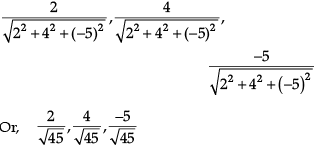Test: Vectors- Assertion & Reason Type Questions - Commerce MCQ
6 Questions MCQ Test - Test: Vectors- Assertion & Reason Type Questions
Direction: In the following questions, A statement of Assertion (A) is followed by a statement of Reason (R). Mark the correct choice as
Assertion (A): The position vector of a point say  and its magnitude is
and its magnitude is 
Reason (R): If  then coefficient of
then coefficient of  are called the direction ratios of vector
are called the direction ratios of vector 
Direction: In the following questions, A statement of Assertion (A) is followed by a statement of Reason (R). Mark the correct choice as
Assertion (A): The area of parallelogram with diagonals 
Reason (R): If  represent the adjacent sides of a triangle, then the area of triangle can be obtained by evaluating
represent the adjacent sides of a triangle, then the area of triangle can be obtained by evaluating 
Direction: In the following questions, A statement of Assertion (A) is followed by a statement of Reason (R). Mark the correct choice as
Assertion (A): The direction of cosines of vector

Reason (R): A vector having zero magnitude and arbitrary direction is called ‘zero vector’ or ‘null vector’.
Direction: In the following questions, A statement of Assertion (A) is followed by a statement of Reason (R). Mark the correct choice as
Assertion (A): The position of a particle in a rectangular coordinate system is (3, 2, 5). Then its position vector be ![]()
Reason (R): The displacement vector of the particle that moves from point P(2, 3, 5) to point Q(3, 4, 5) is ![]()
Direction: In the following questions, A statement of Assertion (A) is followed by a statement of Reason (R). Mark the correct choice as
Assertion (A): The vectors which can undergo parallel displacement without changing its magnitude and direction are called free vectors.
Reason (R): ![]()
Direction: In the following questions, A statement of Assertion (A) is followed by a statement of Reason (R). Mark the correct choice as
Assertion (A): For any two vectors ![]() we always have
we always have ![]()
Reason (R): The given inequality holds trivially when either ![]() in such a case
in such a case
![]()
Then consider
So, let us check it for
![]()

For cos θ ≤ 1, we have :
![]()
![]()
or
![]()
or
![]()





















